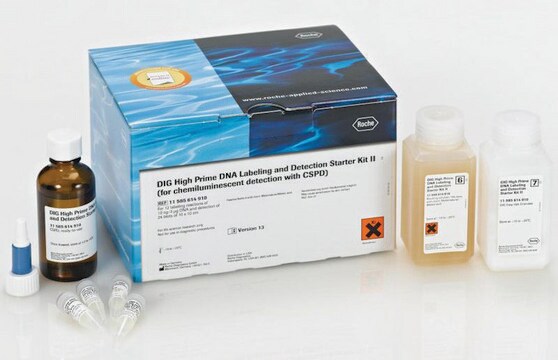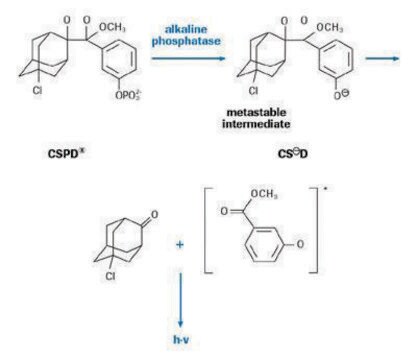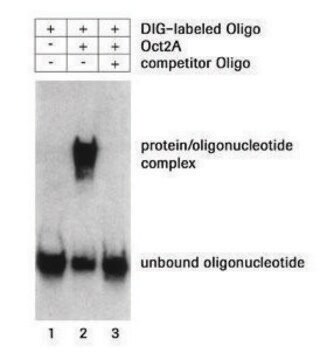11175041910
Roche
DIG Nucleic Acid Detection Kit
sufficient for 40 blots (10 cm x 10 cm each), kit of 1 (5 components), suitable for hybridization, suitable for Northern blotting
Sinónimos:
DIG system
About This Item
Productos recomendados
uso
sufficient for 40 blots (10 cm x 10 cm each)
Nivel de calidad
envase
kit of 1 (5 components)
fabricante / nombre comercial
Roche
características de los productos alternativos más sostenibles
Designing Safer Chemicals
Learn more about the Principles of Green Chemistry.
sustainability
Greener Alternative Product
técnicas
Northern blotting: suitable
Southern blotting: suitable
hybridization: suitable
categoría alternativa más sostenible
, Aligned
temp. de almacenamiento
−20°C
Descripción general
Aplicación
- Southern blots
- Northern blots
- Other nucleic acid blotting applications
- In situ hybridization applications
- Southern blots
- Northern blots
- Other nucleic acid blotting applications
- In situ hybridization applications
Características y beneficios
Envase
Principio
Nota de preparación
Working concentration of conjugate depends on application and substrate.
Storage conditions (working solution):
- Anti-Digoxigenin-AP Conjugate (vial 3): 2 to 8 °C, it is stable for 12 months at this temperature
- NBT/BCIP (vial 4): 2 to 8 °C, stable
Note: During shipment of the kit on dry ice, a precipitate may occur which is dissolved by briefly warming to 37 °C - The blocking reagent (vial 5) is stable for 36 months and can be stored dry at 4 to 8 °C.
- Autoclaved stock solution can be stored for several days to a week either unopened at 15 to 25 °C or at 4 to 8 °C after opening. Alternatively, it can be stored in aliquots at -15 to -25 °C for up to 6 months.
Solo componentes del kit
- DIG-labeled Control DNA 5 µg/ml
- DNA Dilution Buffer, [50 μg/ml] fish sperm DNA
- Anti-Digoxigenin-AP Conjugate antibody 750 U/ml
- NBT/BCIP, 50x stock solution 50x concentrated
- Blocking Reagent
Código de clase de almacenamiento
11 - Combustible Solids
Clase de riesgo para el agua (WGK)
WGK 3
Punto de inflamabilidad (°F)
does not flashNot applicable
Punto de inflamabilidad (°C)
does not flashNot applicable
Certificados de análisis (COA)
Busque Certificados de análisis (COA) introduciendo el número de lote del producto. Los números de lote se encuentran en la etiqueta del producto después de las palabras «Lot» o «Batch»
¿Ya tiene este producto?
Encuentre la documentación para los productos que ha comprado recientemente en la Biblioteca de documentos.
Los clientes también vieron
Artículos
Digoxigenin (DIG) labeling methods and kits for DNA and RNA DIG probes, random primed DNA labeling, nick translation labeling, 5’ and 3’ oligonucleotide end-labeling.
Nuestro equipo de científicos tiene experiencia en todas las áreas de investigación: Ciencias de la vida, Ciencia de los materiales, Síntesis química, Cromatografía, Analítica y muchas otras.
Póngase en contacto con el Servicio técnico









